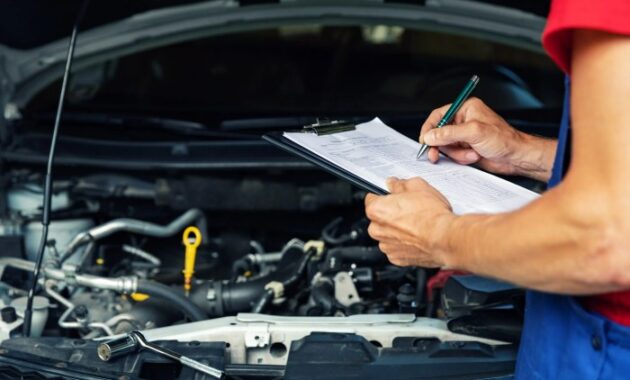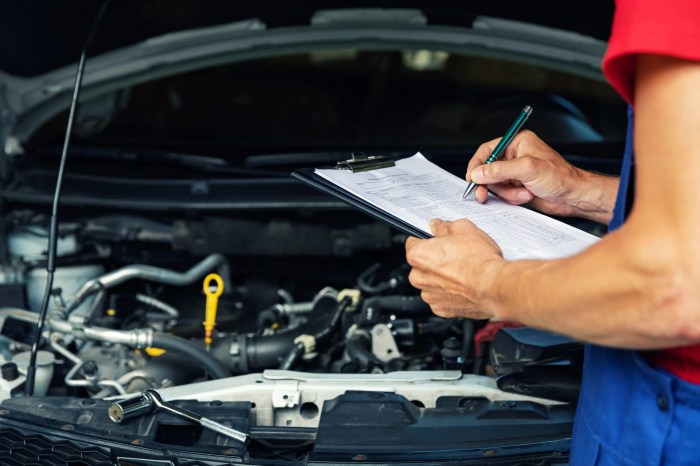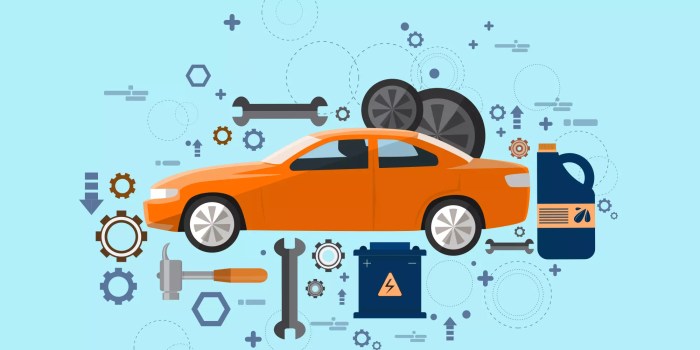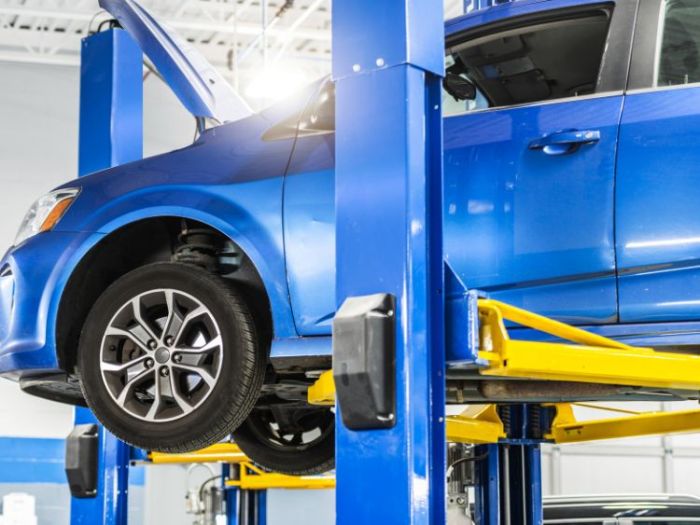
The unexpected clunk, the ominous warning light – these are moments every vehicle owner dreads. While comprehensive insurance protects against accidents, what about the routine wear and tear, the preventative maintenance, and those inevitable, costly repairs? This is where vehicle maintenance insurance steps in, offering a safety net against the financial burden of keeping your vehicle in optimal condition. Understanding the nuances of these plans can save you significant stress and expense down the road.
This guide explores the various types of vehicle maintenance insurance, comparing providers, outlining benefits and drawbacks, and providing a clear path to selecting the plan that best suits your needs and budget. We’ll delve into the factors influencing cost, the claims process, and illustrate real-world scenarios to paint a comprehensive picture of this often-overlooked aspect of vehicle ownership.
Defining Vehicle Maintenance Insurance
Vehicle maintenance insurance offers a financial safety net for unexpected repair costs associated with your vehicle. It’s designed to alleviate the burden of routine and sometimes costly maintenance, offering peace of mind and predictable budgeting for vehicle upkeep. Unlike comprehensive or collision insurance, which covers accidents and damage, maintenance insurance focuses on preventative care and the repair or replacement of specific components as they wear out.
Types of Vehicle Maintenance Insurance Policies
Several types of vehicle maintenance insurance policies cater to different needs and budgets. Some policies cover only routine maintenance like oil changes and tire rotations, while others extend to more extensive repairs, such as brake replacements or air conditioning system servicing. Some plans are offered as standalone policies, while others are bundled with other insurance products. The level of coverage and the specific components included vary significantly depending on the insurer and the chosen plan. Higher-tier plans generally encompass a broader range of covered services and repairs.
Standard Vehicle Maintenance Insurance Coverage
A standard vehicle maintenance insurance plan typically includes coverage for scheduled maintenance tasks. This often involves routine services like oil changes, tire rotations, fluid top-offs (coolant, brake fluid, etc.), and filter replacements (air, fuel, cabin). Some plans might also cover components like belts, hoses, and spark plugs, depending on the policy terms and conditions. It’s crucial to carefully review the policy document to understand precisely what is and isn’t covered to avoid any misunderstandings later. The frequency of covered services may be determined by mileage or time intervals, as specified in the insurance contract.
Comparison of Vehicle Maintenance Insurance Providers
Several companies offer vehicle maintenance insurance, each with its unique offerings and pricing structures. Providers may differ in their coverage limits, deductible amounts, and the network of repair shops they partner with. Some insurers may offer more comprehensive coverage but at a higher premium, while others might offer more basic coverage at a lower cost. It’s vital to compare multiple providers and their plans to find the best fit for your specific vehicle and budget. Customer reviews and independent ratings can also be valuable resources during this comparison process.
Comparison Table of Leading Providers
The following table compares three hypothetical leading providers, illustrating potential differences in coverage, price, and deductible. Note that these are examples and actual figures vary depending on the specific plan, vehicle, and location.
| Provider | Coverage | Annual Price (Estimate) | Deductible |
|---|---|---|---|
| AutoGuard | Basic maintenance (oil changes, tire rotations, filters) | $250 | $50 |
| RoadSafe | Basic + brake components, belts, hoses | $400 | $100 |
| MotorCare | Comprehensive (most routine and some major repairs) | $600 | $150 |
Benefits and Drawbacks of Vehicle Maintenance Insurance

Vehicle maintenance insurance offers a compelling proposition for car owners, promising peace of mind and potentially significant cost savings. However, like any insurance product, it comes with its own set of advantages and disadvantages that require careful consideration before purchasing. Understanding these aspects is crucial for making an informed decision tailored to your individual needs and driving habits.
Financial Advantages of Vehicle Maintenance Insurance
The primary benefit of vehicle maintenance insurance lies in its potential to mitigate the financial burden of unexpected repair costs. Regular maintenance, such as oil changes, tire rotations, and brake pad replacements, can accumulate substantial expenses over the lifespan of a vehicle. This insurance can cover a significant portion, if not all, of these costs, creating a predictable budget for vehicle upkeep. This predictability is particularly valuable for those on a tight budget or those who prefer to avoid large, unexpected expenses. For example, a major repair, like a transmission overhaul, could easily cost thousands of dollars; vehicle maintenance insurance can significantly reduce or eliminate this financial shock.
Potential Disadvantages and Limitations of Vehicle Maintenance Insurance
While offering financial protection, vehicle maintenance insurance is not without its limitations. One common drawback is the potential for higher overall costs if the vehicle requires minimal maintenance. If your car is relatively new and requires little repair, the premiums paid over time might exceed the actual maintenance costs you would have incurred without the insurance. Additionally, the specific services covered vary widely between providers, and some policies may exclude certain components or types of repairs. Carefully reviewing the policy’s terms and conditions is crucial to understanding exactly what is and isn’t covered. For instance, some policies might exclude wear and tear on tires, requiring separate tire insurance.
Situations Where Vehicle Maintenance Insurance is Most Beneficial
Vehicle maintenance insurance proves most beneficial for older vehicles with a higher likelihood of requiring frequent repairs. The unpredictable nature of maintenance needs for older cars makes this type of insurance a valuable tool for budgeting and avoiding unexpected expenses. Similarly, individuals with limited mechanical knowledge or those who lack the time or resources to perform regular maintenance themselves might find this insurance particularly helpful. Drivers who frequently travel long distances or operate their vehicles under demanding conditions (such as heavy towing or off-road driving) might also benefit from the added protection.
Scenarios Where Vehicle Maintenance Insurance Might Not Be Cost-Effective
For newer vehicles under warranty, the cost of vehicle maintenance insurance may outweigh the benefits. Factory warranties often cover many routine maintenance items, rendering the insurance redundant. Likewise, individuals who are mechanically inclined and comfortable performing their own maintenance could find that the cost of the insurance exceeds the cost of performing the maintenance themselves. For example, someone who regularly changes their own oil and performs basic maintenance might find the insurance premiums unnecessary. Finally, drivers with low annual mileage might find that their maintenance costs remain low enough that the insurance isn’t a worthwhile investment.
Factors Affecting Vehicle Maintenance Insurance Costs
Understanding the factors that influence the cost of vehicle maintenance insurance is crucial for making informed decisions. Several interconnected elements contribute to the final premium, and being aware of these can help you secure the best possible coverage at a competitive price. This section will detail the key factors that insurance providers consider when calculating your premium.
Several key factors determine the cost of your vehicle maintenance insurance. These factors interact in complex ways, meaning a small change in one area can significantly impact your overall premium. It’s important to understand these elements to better manage your insurance costs.
Vehicle Age, Make, and Model
The age, make, and model of your vehicle significantly impact maintenance insurance premiums. Older vehicles are more prone to breakdowns and require more frequent repairs, leading to higher insurance costs. Similarly, the make and model play a crucial role; some vehicle brands have a reputation for reliability, resulting in lower premiums, while others might be associated with more frequent and expensive repairs, leading to higher premiums. For example, a well-maintained, newer Honda Civic will likely command a lower premium than an older, high-performance sports car with a history of complex mechanical issues. The cost of parts and labor for repairs also influences the premium; luxury vehicles often have higher repair costs than more common models.
Driving History
Your driving history is a significant factor in determining your maintenance insurance premium. A clean driving record with no accidents or traffic violations will typically result in lower premiums. Conversely, a history of accidents or speeding tickets can significantly increase your premiums. Insurance companies view this as an indicator of higher risk, leading them to charge more to cover potential future repair costs. For example, a driver with multiple at-fault accidents in the past three years will likely pay substantially more for vehicle maintenance insurance than a driver with a spotless record.
Location
Your location also influences your maintenance insurance costs. Areas with higher rates of theft or vandalism will generally have higher premiums, reflecting the increased risk of damage to your vehicle. Similarly, regions with harsh weather conditions (e.g., areas prone to severe snowstorms or hail) may lead to higher premiums due to the increased likelihood of weather-related damage. Insurance companies use statistical data on accidents, theft, and weather events in specific geographic areas to calculate risk and adjust premiums accordingly. For instance, someone living in a high-crime urban area might pay more than someone living in a rural, low-crime area.
Factors Affecting Vehicle Maintenance Insurance Costs: A Summary
The following list prioritizes the most influential factors affecting vehicle maintenance insurance costs:
- Vehicle Age: Older vehicles generally cost more to insure due to increased likelihood of repairs.
- Vehicle Repair History: A history of expensive repairs increases premiums.
- Driving History: Accidents and violations significantly impact premiums.
- Vehicle Make and Model: Some makes and models are inherently more expensive to repair.
- Location: High-risk areas (theft, vandalism, harsh weather) result in higher premiums.
The Claims Process for Vehicle Maintenance Insurance
Filing a claim for vehicle maintenance insurance is generally straightforward, but understanding the process beforehand can streamline the experience. This section details the typical steps involved, necessary documentation, and the procedure for approval and payment. Familiarizing yourself with these steps will help ensure a smooth and efficient claims process.
Steps Involved in Filing a Claim
The claims process typically begins with reporting the necessary maintenance to your insurer. Following this initial report, you’ll need to provide supporting documentation and await assessment. Once approved, the insurer will process the payment according to the policy terms. This usually involves a few key steps, from initial notification to final payment disbursement. Delays can sometimes occur depending on the complexity of the claim or the availability of necessary parts.
Required Documentation and Information
To successfully file a claim, you’ll need to provide comprehensive documentation supporting your request. This typically includes proof of purchase for the vehicle maintenance service, the policy details, and possibly additional supporting evidence depending on the nature of the repair. Failure to provide complete documentation may delay the processing of your claim.
- A copy of your vehicle maintenance insurance policy.
- Detailed invoices or receipts for the maintenance performed, clearly showing the date, services rendered, and cost.
- Photographs or videos of the maintenance work, if applicable, to verify the need for the repairs.
- Your vehicle’s registration documents.
- A completed claim form provided by your insurer.
Approval and Payment Process
Once your insurer receives your claim and supporting documentation, they will review the information to determine its validity. This review process may involve verifying the costs with the service provider. Upon approval, the insurer will typically process the payment according to the terms Artikeld in your policy. Payment methods vary, with some insurers offering direct deposit or check payments.
Claims Process Flowchart
The following description Artikels a typical claims process flowchart. Imagine a flowchart with boxes and arrows.
* Box 1: Report Maintenance Need: This is the starting point, where the policyholder reports the required maintenance to the insurance company.
* Arrow 1: Points from Box 1 to Box 2.
* Box 2: Submit Documentation: The policyholder submits all necessary documentation, as Artikeld above, to support their claim.
* Arrow 2: Points from Box 2 to Box 3.
* Box 3: Insurer Review: The insurance company reviews the submitted documentation and assesses the claim.
* Arrow 3: Points from Box 3 to Box 4 (Approval) or Box 5 (Rejection).
* Box 4: Claim Approved: If approved, the insurer processes the payment according to the policy terms.
* Arrow 4: Points from Box 4 to Box 6.
* Box 5: Claim Rejected: If rejected, the insurer will typically provide a reason for the rejection. The policyholder may have the opportunity to appeal the decision.
* Arrow 5: Points from Box 5 to Box 7 (Appeal) or Box 6 (End).
* Box 6: Payment Received: The policyholder receives payment for the approved maintenance. This is the end of the process for approved claims.
* Box 7: Appeal Process: The policyholder initiates an appeal process, potentially resubmitting documentation or providing further clarification. This process may loop back to Box 3.
Choosing the Right Vehicle Maintenance Insurance Plan
Selecting the appropriate vehicle maintenance insurance plan requires careful consideration of your individual needs and driving habits. A plan that’s perfect for one driver might be inadequate or overly expensive for another. Understanding your vehicle’s requirements and your budget is crucial for making an informed decision.
Choosing the right vehicle maintenance insurance plan involves comparing various factors to find the best value for your money. This process helps ensure your vehicle receives the necessary maintenance while minimizing unnecessary expenses. By carefully evaluating different plans and providers, you can secure a policy that offers comprehensive coverage tailored to your specific circumstances.
Policy Comparison and Provider Evaluation
Before committing to a plan, compare policies from several reputable providers. Look beyond the advertised price and delve into the specifics of the coverage. Consider factors such as the types of maintenance covered, the limits on coverage amounts, and any exclusions or limitations. Check online reviews and ratings to gauge the reputation and customer service of each provider. For example, comparing a plan offering basic oil changes and tire rotations against one including more comprehensive engine maintenance reveals significant differences in coverage and cost. This comparison will help you determine which plan best suits your needs and budget.
Understanding Policy Terms and Conditions
Thoroughly review the policy’s terms and conditions before signing. Pay close attention to the definition of covered services, exclusions (such as wear-and-tear items not covered), deductibles, and the claims process. Understanding these aspects prevents surprises and ensures you know exactly what is and isn’t included in your coverage. For instance, some policies may exclude certain repairs deemed to be the result of driver negligence, while others might have a limit on the number of services covered within a specific timeframe. Clarity on these points is essential.
Evaluating Value and Cost-Effectiveness
Assess the value of each plan by comparing the total cost against the expected maintenance expenses for your vehicle. Consider your vehicle’s age, mileage, and typical maintenance needs. A more expensive plan might be cost-effective if it covers significant repairs that would otherwise be costly out-of-pocket. For example, a vehicle nearing the end of its warranty period might benefit from a comprehensive plan covering potential major repairs, even if it’s more expensive upfront. Conversely, a newer vehicle with minimal expected maintenance needs might find a basic plan sufficient and more cost-effective. The key is to balance the cost of the plan with the potential savings on future repairs.
Illustrative Examples of Vehicle Maintenance Coverage

Understanding how vehicle maintenance insurance works is best achieved through real-world examples. These examples illustrate scenarios where coverage is provided, as well as situations where a claim might be denied.
Major Repair Covered
Imagine your car’s engine unexpectedly fails. A diagnostic reveals a catastrophic failure of the timing belt, resulting in significant internal engine damage. Repair costs are estimated at $4,500. Assuming your vehicle maintenance insurance policy includes engine component coverage and has a sufficiently high coverage limit, the majority, if not all, of this repair cost would be covered. The deductible, as stipulated in your policy, would be your responsibility. This highlights the financial protection offered by comprehensive maintenance insurance.
Minor Repair Covered
Your car’s windshield wipers fail to function effectively during a heavy downpour. Upon inspection, a mechanic determines that the wiper motor needs replacement. The cost of the new motor and its installation is $150. Many vehicle maintenance plans cover routine maintenance items such as wiper motor replacement, provided it’s not due to driver negligence (e.g., running the wipers dry). This minor repair is a typical example of the everyday maintenance issues a policy can address.
Claim Denied Due to Policy Exclusions
You experience a flat tire due to running over a large piece of debris on the highway. While your policy covers tire replacements under certain circumstances (e.g., punctures from road hazards), it explicitly excludes damage caused by willful negligence. Because you were driving on a visibly damaged tire that you had known about for some time prior to the incident, the claim for a new tire is denied. This underscores the importance of reading the policy’s fine print and understanding its exclusions.
Covered Repair: Brake System Overhaul
This illustration depicts a covered repair to a vehicle’s brake system.
| Component | Description | Cost |
|---|---|---|
| Brake Pads (Front & Rear) | Worn brake pads replaced with high-quality OEM parts. | $200 |
| Brake Rotors (Front) | Severely warped rotors replaced to ensure safe braking performance. | $300 |
| Brake Fluid Flush | Old brake fluid replaced with fresh fluid to maintain optimal braking efficiency. | $75 |
| Brake Caliper Inspection & Lubrication | Calipers inspected for wear and tear; lubrication applied to prevent sticking. | $50 |
| Labor | Mechanic’s labor for parts replacement and system testing. | $275 |
| Total | $900 |
This illustrates a scenario where the policy covers the comprehensive overhaul of the braking system, addressing multiple components. The costs are representative and may vary depending on location and vehicle make/model.
Last Word

Ultimately, the decision of whether or not to invest in vehicle maintenance insurance is a personal one, dependent on factors such as vehicle age, driving habits, and financial comfort levels. By carefully weighing the benefits and drawbacks, understanding the claims process, and selecting a plan that aligns with your specific needs, you can effectively mitigate the financial risks associated with vehicle upkeep. Proactive planning and informed decision-making can transform unexpected repair bills into manageable expenses, ensuring your vehicle remains reliable and roadworthy for years to come.
Helpful Answers
What is the difference between vehicle maintenance insurance and an extended warranty?
Extended warranties typically cover major mechanical components for a specified period, while vehicle maintenance insurance often covers a broader range of services, including routine maintenance like oil changes and tire rotations.
Can I cancel my vehicle maintenance insurance policy early?
Yes, but there may be cancellation fees depending on your policy terms and the provider. Review your policy documents carefully before cancelling.
What happens if my vehicle is totaled while covered by maintenance insurance?
The maintenance insurance coverage typically ends when the vehicle is declared a total loss by your comprehensive insurer. You will not receive reimbursement for unused portions of your plan.
Are there any mileage restrictions on vehicle maintenance insurance?
Some plans may have mileage restrictions, limiting coverage based on annual mileage. Check your policy details for specifics.